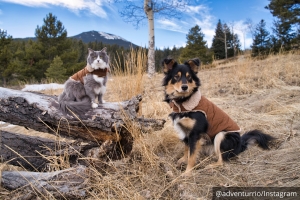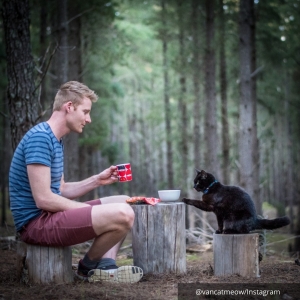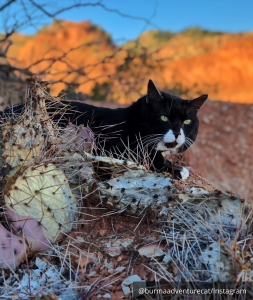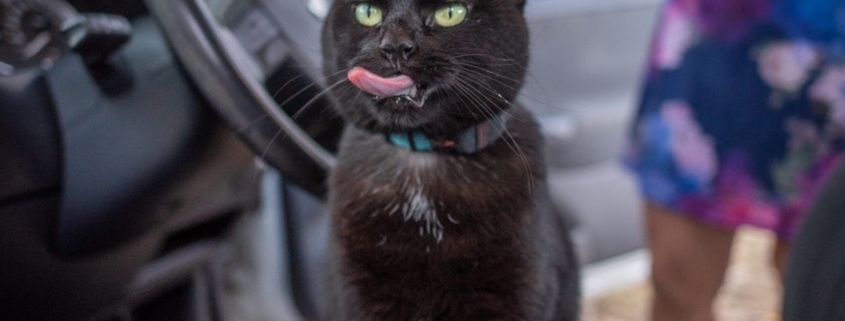BY CHERESE COBB, FREELANCER
You thought Marco Polo was well-traveled? You ain’t seen nothin’ yet. From Caracas to Tasmania, these Instafamous pets capture the spirit of adventure—follow them now.
1. Miami@miami_traveller_dog
Miami is one of the world’s most jet-setting pets. “He’s an unusual Chihuahua because he’s sweet and friendly with everyone,” says owner Marianna Chiaraluce. She adopted him when he was 7 months old. He was unsuitable for canine competitions because of a minor health issue. “But this made me love him even more,” she says. Their very first adventure was a three-month road trip from Chicago to Los Angeles. Since then, Miami has visited President Lincoln’s house in Springfield, Ill.; Elvis’ birthplace in Memphis, Tenn.; and the Gateway Arch in St. Louis, Mo. He’s also the Pet General Manager at The Box in Riccione, one of the best-known seaside resorts in Northern Italy.

2. Aspen@aspenthemountainpup
Photographer Hunter Lawrence shares Aspen with 284K followers on Instagram. He adopted the Golden Retriever from a small coastal town near Houston, Texas. On Thanksgiving morning in 2012, he saw a listing for a new litter of puppies posted online. He immediately ran out the door to go check them out. Aspen loves getting buried in the snow, even if he sometimes eats snowballs, and diving into icy water. He’s visited eight different states and Lake Louise in Alberta, Canada—one of the prestigious stops on the World Cup skiing circuit. The 8-year-old currently lives in Santa Barbara, Calif. Whether he’s basking in the sunshine or in an ice cream coma, he always has the biggest smile on his face. “He’s genuinely happy…if we’re near him, he just lights up,” Lawrence says.

3. Snupi@podroze_z_pazurem
Snupi (which means sweet in Dutch) is undoubtedly the most famous dog in Poland. He has his own comic book called “Travels with Claw.” “We know very little about his past,” says owner Izabella Miklaszewski. “He was adopted by a family but returned after a week, possibly because of the cost of treating his kennel cough.” The 12-year-old mongrel has visited 36 countries on five continents. He’s also traveled over 3,200 nautical miles crossing the Amazon River and the Atlantic Ocean from Morocco to Brazil. Snupi has also conquered the 13,123-foot peak of Toubkal in Morocco. His record altitude is 19,101 feet above sea level at the Misti Volcano in Peru. He’s also trekked through the Cordillera Huayhuash, an 81-mile trail with an elevation between 10,826 and 18,012 feet.

4. Rio and Bruce@adventurrio
Best friends Rio and Bruce have been to eight states and nine national parks. Rio is a 3-year-old gray and white domestic longhair. She didn’t instantly warm up to her 1.5-year-old dog sidekick. “It took a little while for them to really become friends. But Rio is a very brave kitty and quickly figured out that Bruce is a great play buddy,” says owner Maria Roper. “When we go hiking Rio normally follows Bruce’s lead. When we’re exploring a campsite, it’s the opposite. Rio explores and Bruce follows her around, and they’re just so cute together.” Last summer, the traveling cat and dog duo camped in the Black Hills. They napped on rocks together whenever they got tired. Then Rio and Bruce visited Sequoia National Forest and the Pacific coast, where they saw the ocean for the first time.

5. Willow@vancatmeow
Unhappy after 10 years in the corporate world, Rich East sold his house and all of his possessions. Then he quit his job to travel with his rescue cat Willow in a campervan. Since leaving their hometown of Hobart, Tasmania, they’ve covered more than 31,000 miles. “Willow spends most of her time off leash with supervision. She rarely wanders more than 100 yards from the van, but when she does, I can find her with her tracking collar,” East says. “She’s made my van a home and the whole of Australia her backyard.” The 6-year-old has visited New South Wales, Queensland, Northern Territory, Western Australia, South Australia, Victoria and the Australian Capital Territory.

6. Burma@burmaadventurecat
An Iraqi war vet with post-traumatic stress disorder and depression, Stephen Simmons was homeless. For five years, he lived out of his Jeep with his military service dog Puppi. In April 2013, he was sitting outside a grocery in Grants Pass having a sandwich when a homeless girl came up with a box of free kittens. Simmons held Burma and couldn’t resist him. The black cat spent the first eight weeks of his life in a damp tent during the cold, rainy Oregon winter. Burma, who has 73K Instagram fans, has traveled to 31 states with Simmons and his girlfriend, Nicole Rienzie. She and her two Instafamous cats, Monk and Bean, have also joined the trio, becoming a blended family of six. “Although Burma grew up on the go…he’s made me believe in something much bigger than us and this world again,” Simmons says.

7. Max and Louise@max_et_louise
Thiago Ferreira documents the adventures of Parson Russell Terriers Max and Louise who have 68K Instagram followers. Max arrived in 2009 for Christmas. He was only 49 days old. Louise was Max’s Christmas gift a few years later. Before she was adopted in Caracas, Venezuela, Max used to sleep most of the time. But since that day, he’s had his own partner in crime. Max and Louise have lived with the photographer in Paris and Lisbon and accompany him every year when he visits Rio de Janeiro for Christmas. “They love to jump off boats for a dip in the water,” Ferreira says. They’ve visited the French Alps, Las Vegas, the Greek island of Mykonos, the Leaning Tower of Pisa and Miami Beach.

8. Lilo@lowrider_lilo
Lilo is a 4-year-old Pembroke Welsh corgi from Calgary, Alberta. Wearing bandanas and Corgi goggles (or “coggles”), she’s been adventuring in the Canadian Rockies since 2016. “We started Lilo on short hikes with barely any elevation first, then slowly built up her endurance and stamina to longer and harder hikes,” says owner Aiko Dolatre. “Even with that, we still have to be mindful of her health, not letting her jump down from high places on the trail and keeping a closer eye on her in hot weather conditions.” Lilo has ridden a wooden horse in the Enchanted Forest and braved the Capilano Suspension Bridge. She’s also visited Prairie Mountain, Sunwapta Falls, Johnston Canyon and Moraine Lake.

9. Ollie@explorewithollie
Born and raised in Dallas, Texas, Stephen Martin joined the Army in 2005. Seven years later, he moved from his duty station at NATO headquarters in Brussels, Belgium to Colorado Springs. That’s where he adopted Ollie, a Wirehaired Fox Terrier mix, who’s climbed 37 of Colorado’s 14ers. Ollie, who has 21K Instagram followers, loves drinking out of creeks and lying down in them. Martin and Ollie start hiking at 3 a.m. and sit on the peak for an hour or two before sunrise. Because dogs see in dichromatic color, Martin doesn’t really know what a gorgeous sunrise looks like to Ollie.“But he’ll sit there on the rock next to me…and I watch him enjoy it,” he says. “I feel like he knows when we reach the top.”

4 Hidden Travel Dangers for Pets
Want to live with no excuses and no regrets?
Here are 4 dangers to watch out for.
BY CHERESE COBB, FREELANCER
Anxiety: According to “Scientific Reports”—an online multidisciplinary open-access journal—50 percent of dogs are afraid of loud noises, heights and walking on metal grids. Cats are commonly stressed by another person or pet. “So let your pets sniff all the things they want to sniff. Let them hide if something spooks them—in your arms or a backpack, so you become their safe space,” Roper says. “They’ll gradually build more and more confidence and learn to love new experiences.”
Fishing Gear: Keep them away from your tackle boxes and bait buckets. Dogs often get fishing hooks stuck in their nose and tongue. It’s not rare to see dogs that have swallowed, well…hook, line and sinker. If you’ve got any lead sinkers or jigheads lying around, be careful. If your dogs are naughty enough to swallow one (or several), they can cause lead poisoning.
Pressure-Treated Wood: Pressure-treated wood is coated with chromate copper arsenate (CCA) that protects it from insects and rot. Because it lasts 20 years or more, it’s been used to build 90 percent of all outdoor wooden structures in the US, says the Environmental Working Group. CCA is dangerous because it’s made with arsenic. It can seep into the soil and pool on wooden surfaces. Whether you’re picnicking or fly fishing on an arsenic-treated deck, keep an eye on your pets. Don’t let them lap up puddles or play in dirt that could have ashes from a CCA wood fire. One tablespoon contains a fatal dose of arsenic.
Snakes: According to a new study published in “Comparative Biochemistry and Physiology,” cats are twice as likely to survive venomous snake bites than dogs. That’s because they often swat at snakes with their paws while dogs investigate them with their nose and mouth. Venom acts faster on dog plasma than cats or humans. Without snakebite first aid, dogs will quickly bleed to death. “Dogs are usually more active than cats, which isn’t great after a bite has taken place,” writes Lead Researcher Bryan Fry. “The best practice is to remain as still as possible to slow the spread of venom through the body.”
















